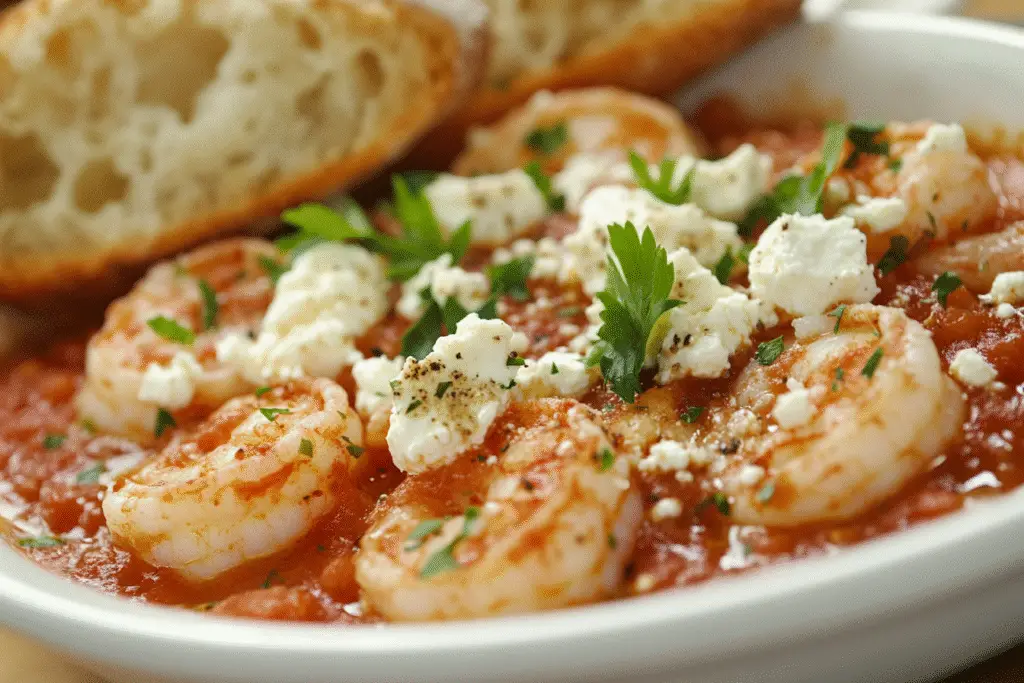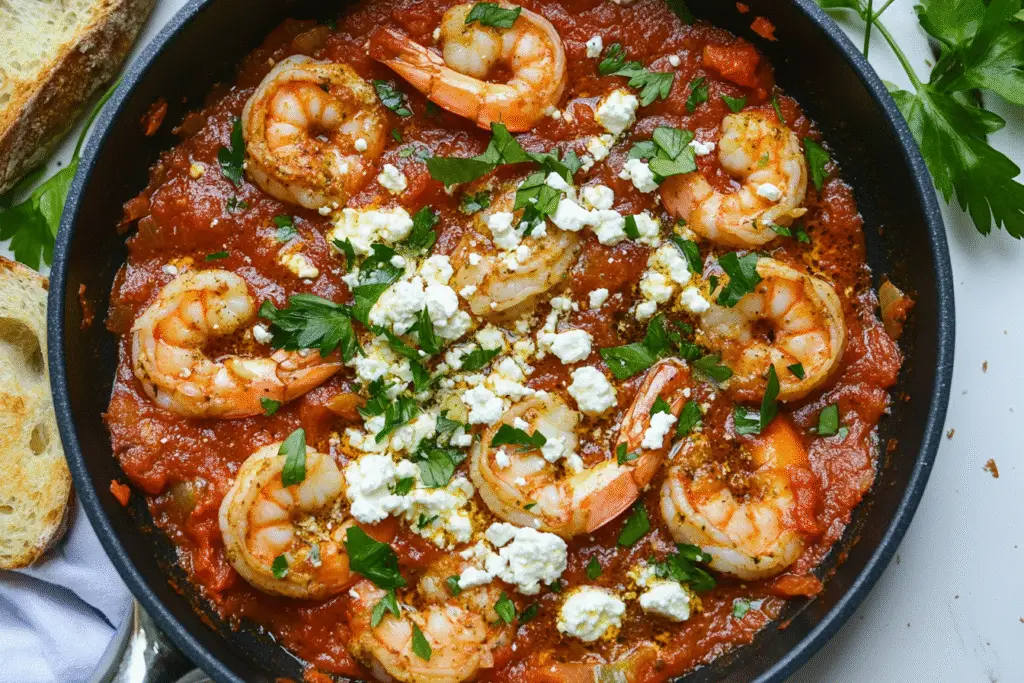Shrimp saganaki is a traditional Greek dish that beautifully combines tender shrimp, a savory tomato sauce, salty feta cheese, and fresh herbs, all finished with a hint of citrus. It’s a vibrant, one-pan meal that’s typically served as a meze (appetizer) but is also substantial enough to be enjoyed as a main dish with crusty bread or rice.
The word “saganaki” refers to the small, two-handled frying pan traditionally used to make this dish, but you don’t need special equipment—any oven-safe skillet works. Shrimp saganaki is celebrated for its rich, layered tomato sauce infused with garlic, onions, and a subtle heat from chili flakes, all topped with creamy, briny feta that softens as it bakes.
This is a dish that feels luxurious but comes together quickly, making it perfect for a weeknight dinner or a rustic centerpiece for sharing.
In this step-by-step Shrimp Saganaki Recipe, I’ll walk you through selecting the right shrimp, building a flavorful sauce, avoiding common pitfalls, and offering tasty variations to make this dish your own.

Why Shrimp Saganaki Can Go Wrong: Common Pitfalls and How to Avoid Them
Shrimp saganaki is quick, but timing and layering flavors properly are key.
Common Mistakes:
- Overcooked shrimp: Shrimp can become rubbery if left in the oven too long.
- Watery sauce: Occurs if tomatoes aren’t simmered enough to reduce properly.
- Overly salty dish: Can happen if using very salty feta without balancing the sauce.
- Flat flavor: Skipping fresh herbs or citrus can leave the dish lacking brightness.
Keys to Success:
- Simmer the tomato sauce until thick before adding shrimp.
- Use good-quality feta that softens but holds its shape.
- Add shrimp and bake just until pink—overbaking will toughen them.
- Finish with fresh parsley and lemon juice to brighten and balance the dish.

Choosing the Best Ingredients for Shrimp Saganaki
Shrimp
- Medium or large shrimp (16-30 count per pound) are perfect.
- Fresh or thawed frozen shrimp, peeled and deveined.
- Tails can be left on for presentation or removed for easier eating.
Tomatoes
- Crushed canned tomatoes or fresh ripe tomatoes work well.
- Tomato paste adds richness and depth.
Cheese
- Good-quality feta cheese, preferably in brine, is essential for creamy, tangy contrast.
Aromatics and Seasonings
- Garlic, onion, and red pepper flakes create the base flavor.
- Oregano (fresh or dried) is traditional.
- Fresh parsley and lemon juice lift the dish at the end.
Essential Equipment
- Oven-safe skillet or baking dish: For stovetop-to-oven cooking.
- Mixing spoon: For stirring sauce and layering shrimp.
- Citrus juicer: For fresh lemon juice.
If you don’t have an oven-safe skillet, you can make the sauce on the stovetop and transfer everything to a baking dish before broiling.
Smart Preparation Tips
Preparation Timeline:
- Active prep: ~15 minutes
- Cooking: ~20-25 minutes
Prep Checklist:
- Peel and devein shrimp ahead of time.
- Crumble feta and chop parsley before starting.
- Preheat oven or broiler in advance.
Flavor Variations and Customizations
- Spicy Version: Increase red pepper flakes or add fresh chili.
- Herb-Rich: Add fresh basil or dill for a Mediterranean twist.
- With Olives: Kalamata olives add briny depth.
- Over Pasta: Serve as a sauce for linguine or orzo.
Common Mistakes and How to Fix Them
- Shrimp overcooked: Bake just until shrimp are pink and opaque.
- Watery sauce: Simmer longer to reduce before adding shrimp.
- Overly salty: Balance with a splash of lemon juice and don’t oversalt the sauce.
- Dry shrimp: Ensure there’s enough sauce in the pan to surround the shrimp.
Storage, Freezing, and Reheating Tips
- Storage: Store in an airtight container in the fridge for up to 2 days.
- Freezing: Not recommended; shrimp texture and feta quality suffer after freezing.
- Reheating: Reheat gently in a skillet over low heat. Avoid microwaving to prevent tough shrimp.
Shrimp Saganaki Recipe
Ingredients
For the Shrimp Saganaki:
- 3 tablespoons olive oil
- 1 small onion, finely chopped
- 3 cloves garlic, minced
- ½ teaspoon red pepper flakes (optional)
- 1 tablespoon tomato paste
- 1 (14-ounce) can crushed tomatoes
- ½ cup dry white wine (or seafood/chicken broth)
- 1 teaspoon dried oregano (or 1 tablespoon fresh)
- Salt and black pepper, to taste
- 1 pound large shrimp, peeled and deveined
- 5 ounces feta cheese, crumbled
- Fresh parsley, chopped (for garnish)
- Juice of half a lemon
For Serving:
- Crusty bread
- Lemon wedges
- Optional: Cooked orzo or rice
Step-by-Step Instructions
Step 1: Make the Tomato Sauce
- Preheat oven to 400°F (200°C).
- Heat olive oil in an oven-safe skillet over medium heat.
- Sauté onion for 5-7 minutes until soft and translucent.
- Add garlic and red pepper flakes; cook for 30-60 seconds until fragrant.
- Stir in tomato paste and cook for 1 minute.
- Pour in crushed tomatoes, white wine, oregano, salt, and pepper.
- Simmer uncovered for 10-12 minutes until sauce thickens.
Step 2: Add Shrimp and Feta
- Nestle shrimp into the sauce in a single layer.
- Sprinkle crumbled feta over the top.
Step 3: Bake
- Transfer skillet to the oven and bake for 8-10 minutes, just until shrimp turn pink and feta softens.
- (Alternatively, broil for 3-5 minutes until feta begins to brown slightly.)
Step 4: Finish and Serve
- Remove from oven and drizzle with fresh lemon juice.
- Garnish with chopped parsley and serve immediately with crusty bread.
Serving Suggestions
- With Crusty Bread: Perfect for scooping up the sauce and melted feta.
- Over Orzo or Rice: Makes a more filling main dish.
- With a Greek Salad: Adds freshness and balance.
- As a Meze Platter: Serve alongside olives, hummus, and grilled vegetables.
Shrimp Saganaki Variations: Classic vs. Spicy vs. Olive-Enhanced
| Feature | Classic Shrimp Saganaki | Spicy Shrimp Saganaki | Olive Shrimp Saganaki |
|---|---|---|---|
| Heat Level | Mild | Medium to hot | Mild |
| Key Additions | Tomato, feta, herbs | Extra red pepper flakes | Kalamata olives |
| Serving Style | Bread, orzo, salad | Bread, orzo, salad | Bread, rice, meze platter |
FAQs and Troubleshooting
Can I use frozen shrimp?
Yes, just thaw completely and pat dry.
What’s a good feta substitute?
Try soft goat cheese, though feta provides the signature briny contrast.
Can I skip the wine?
Yes, substitute with seafood or chicken broth.
How do I prevent overcooked shrimp?
Bake or broil just until the shrimp turn pink—watch closely.
Can I make this ahead?
You can prepare the sauce in advance but add the shrimp and bake just before serving.
Final Thoughts
Shrimp saganaki is a bold, comforting, and effortlessly elegant dish that beautifully blends tender shrimp, savory tomato sauce, and creamy feta into a perfect one-pan meal. With its layers of garlic, herbs, and citrus, it’s a standout addition to weeknight dinners, weekend gatherings, or a Mediterranean-inspired spread.
This detailed recipe ensures you’ll create perfectly cooked shrimp, a balanced, rich sauce, and just the right touch of briny feta every time, whether you keep it classic, add extra spice, or customize with olives and fresh herbs. Shrimp saganaki is a Greek favorite you’ll want to make again and again.
